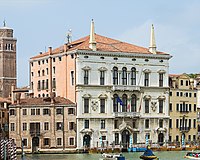
Venetian Renaissance architecture
Venetian Renaissance architecture began rather later than in Florence, not really before the 1480s,[1] and throughout the period mostly relied on architects imported from elsewhere in Italy. The city was very rich during the period, and prone to fires, so there was a large amount of building going on most of the time, and at least the facades of Venetian buildings were often particularly luxuriantly ornamented.
Compared to the Renaissance architecture of other Italian cities, there was a degree of conservatism, especially in retaining the overall form of buildings, which in the city were usually replacements on a confined site, and in windows, where arched or round tops, sometimes with a classicized version of the tracery of Venetian Gothic architecture, remained far more heavily used than in other cities.[4] The Doge's Palace was much rebuilt after fires, but mostly behind the Gothic facades.
The Venetian elite had a collective belief in the importance of architecture in bolstering confidence in the Republic, and a Senate resolution in 1535 noted that it was "the most beautiful and illustrious city which at present exists in the world".[5] At the same time, overt competition between patrician families was discouraged, in favour of "harmonious equality", which applied to buildings as to other areas,[6] and novelty for its own sake, or to recapture the glories of antiquity, was regarded with suspicion.[7] Though visitors admired the rich ensembles, Venetian architecture did not have much influence beyond the republic's own possessions before Andrea Palladio (1508–1580), whose style of Palladian architecture became hugely influential some time after his death, not least in the English-speaking world.
Early buildings[edit]
The Venice Arsenal's main gate, the Porta Magna, was built in the late 1450s and was one of the first works of Venetian Renaissance architecture. It was based on the Roman Arch of the Sergii, a triumphal arch in Pula in Istria, now in Croatia but then Venetian territory. From around the same date, the Arco Foscari, an elaborate canopy or triumphal arch for the ceremonial entrance in the courtyard of the Doge's Palace, is classical in its lower levels, but becomes a forest of Gothic pinnacles by the top.[19]
Venetian books on architecture[edit]
Venice was a major European centre for all book printing publishing, and became the major centre for architectural publishing. Vitruvius is the only significant classical writer on architecture to survive, and his work De architectura was keenly studied by all Renaissance architects. Although the Latin text had been printed before, the first edition illustrated with woodcuts was produced by Fra Giovanni Giocondo in Venice in 1511;[38] he had designed the Fondaco dei Tedeschi in 1505–08.
The "Seven Books" or Tutte l'opere d'architettura et prospetiva of Sebastiano Serlio (1475–1554) were also published in Venice, in several volumes from 1537 onwards. He had worked in the city as an architect, but left little mark. These were also heavily illustrated and became essential reading, and quickly copied and translated around Europe.[39] The patrician humanist, clergyman and Venetian diplomat Daniele Barbaro was a patron of Palladio (Villa Barbaro), and Palladio illustrated his Italian translation of Vitruvius (1556). Palladio's own I quattro libri dell'architettura (1570), illustrated by himself, again had a huge influence across Europe.[40]
Vincenzo Scamozzi's main book L’Idea dell’Architettura Universale was published in 1615, and essentially looks back to Palladio; it was influential in spreading Palladianism.[41]
External paintings[edit]
A considerable number of secular buildings had paintings on external walls, usually the facade. These were sometimes by major artists, but they have virtually all vanished now. A few very faded fragments of the frescos of around 1508 by Giorgione and Titian, mentioned by Vasari, were later removed and are now in the Ca'D'Oro. Giorgione also painted the entrance hall of the Ca' Vendramin Calergi.[42]
Byzantine revivalism[edit]
Venice had no history as an ancient Roman settlement, being founded on mudbanks in the Venetian Lagoon after the fall of the Roman Empire. Venetians liked to claim that the lack of any pagan contamination in their history gave a special "pure, legitimate and undefiled" quality to their Christianity.[43] But the history of the city was for long intimately tied up with the Byzantine Empire, and references to Byzantine architecture were regarded as congenial to the ethos of the city's identity. This can be seen in the interior of San Salvador, on which several architects worked. Begun in 1508, soon after the St. Peter's Basilica in Rome, among other things this large church with an interior based on Greek crosses represented a Venetian riposte to Roman revivalism.[44]














